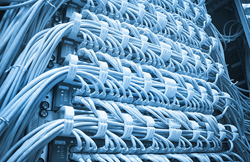Big Data: We’re Looking for a Few Good Nerds (And When We Say “Few,” We Mean 4.4 Million of Them)
09 November 2012

10 or 15 years ago, it was all about bandwidth. big data hiring‘Rich, golden fields of bandwidth, waving in the wind,’ went one well-known technology company. Back then, the major difficulty for the IT industry was preparing an infrastructure that would support what we now think of as Web 2.0 – particular streaming video in vast quantities. Maximizing throughput and minimizing data chokepoints was the order of the day – and fiber-optic installers were working overtime.
Now that that fiber and T-1 backbone has been largely built-out, data producers are looking for efficient ways to store it, secure it from corruption or compromise, and preserve it against loss.
Call it the clouds of data moving over those waving fields of bandwidth – though the term ‘data farm’ is more apt.
The demand for data storage translates into a need for large numbers of high-speed computers with tons of memory, stored in climate-controlled, fortified and secured facilities with redundant power supplies, biometric access systems, collocation facilities to minimize latency drag, and all the racks, cables, coffee machines and institutional brown carpeting and white tile floors and fluorescent lighting that always seems to go along with that.
Uncle Sam Wants You… To Hook Up These Servers
The industry that supports all that is called Big Data – and Big Data wants help.
The IT and HR consulting firm Gartner, Inc. now projects that Big Data is going to need another 4.4 million workers worldwide to service the exploding need for data – and that within the next three years. Gartner also projects that 1.9 million of these jobs will be in the United States.
That’s a lot of demand pull on a limited number of highly-skilled computer and electronic engineers and technicians.
And that 1.9 million figure is just for the IT pros. Gartner estimates that an average of three support workers will be needed to support every pocket-protector as the industry builds out. The challenge: There simply aren’t enough qualified technicians to meet demand. Gartner estimates that two-thirds of those IT jobs are not going to be filled.
Drivers of Demand

Cloud Computing
Cloud computing is by far the biggest driver of the Big Data explosion, according to Gartner’s global research director Peter Sondergaard.
“Cloud is not merely about cost-cutting, the end game is not just cheap on-demand services. In fact, 90 percent of these services are still subscription based, not pay-as-you-go,” Sondergaard said. “We are just at the beginning of realizing the cost benefits of cloud, but organizations moving to the cloud are also attracted by the new capabilities they do not get today. It is bringing new approaches to designing applications, specifically for the cloud, and providing more resilience by architecturing failure as a design concept. Cloud also teaches us about services and service levels, and the contrast between what the business wants for outcomes versus IT’s old methods of getting there.”
Mobile Technologies
The second catalyst driving Big Data growth is the SmartPhone revolution. Smartphones and pad devices are getting rapid and deep penetration – and their limited onboard storage and increased access to online applications is forcing industry to rapidly build out their data storage capabilities.
Gartner projects that there will be 1.6 billion new smart mobile device purchases in 2016. At least two out of every three workers will own a smartphone, and 4 in 10 workers will be mobile. Sondergaard anticipates that iPads will be more ubiquitous than Blackberries. Apple is selling tens of thousands of iPads on single purchase orders to IT directors seeking to transform their field forces. The Blackberry was primarily a communication device. But the iPad is becoming much more than a communications platform – it’s increasingly becoming a presentation medium and customer interface medium as well. By 2018, says Sondergaard 7 out of every 10 workers will be using a tablet or similar device.
“Mobile is about computing at the right time, in the moment. It is the point of entry for all applications, delivering personalized, contextual experiences,” Mr. Sondergaard said. “It means: marketing gets more time with the customer; employees become more productive; and process flows get dramatically cut.”
Social Media and AV
The third catalyst driving Big Data is Social Computing. First it was MySpace, then Facebook. Then Twitter, Tumblr and Pinterest – each of which is generating its own demand for server space. More technologies are on the horizon. And, of course, lossless audio and lossless video formats will also become more and more in demand as consumers wean themselves away from heavily compressed MP3 files (good riddance) and expect 5.1 and 7.1 audio and high-def resolution, even right down to the mobile level. The potential is there for surround sound headphones, for example – and the demand for bandwidth and storage space will explode as more media is converted to the superior file formats.
““Big data is about looking ahead, beyond what everybody else sees,” Mr. Sondergaard said. “You need to understand how to deal with hybrid data, meaning the combination of structured and unstructured data, and how you shine a light on ‘dark data.’ Dark data is the data being collected, but going unused despite its value. Leading organizations of the future will be distinguished by the quality of their predictive algorithms. This is the CIO challenge, and opportunity.”
So What’s Needed?
Think data architecture, for the most part. And low-voltage security system experts, since these data farms are going to have to be stored somewhere – and they will all have access control systems of some sort. Biometric systems are becoming the industry standard in the top-end facilities. A recent report for IT Business Edge indicated that the industry anticipates a need for business intelligence analysts, networking engineers, cable jockeys (someone’s gotta run all that wire!), a CIO type, a data center manager type (three shifts and a head), analysts, garden-variety screw-turners who can open a computer crate and replace a faulty bus, fan or disc array, and of course a facilities manager who knows how to fix the AC.
I’m also thinking the need for espresso machine repair professionals and pizza delivery drivers will be intense.
We’ve got quite a few network engineering jobs ourselves.
Check out Vitaver’s CAREER section!




